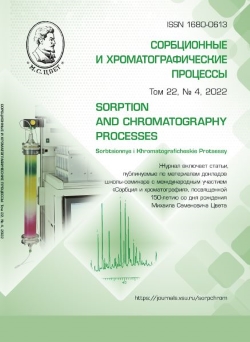Determining the enthalpy of the transfer of anthocyanidins from the mobile phase to the stationary phase during reversed-phase chromatography on a С18 stationary phase
Abstract
The article focuses on the dependence of the retention of 3-glucosides of six common anthocyanidins: delphinidin, petunidin, malvidin, cyanidin, peonidin, and pelargonidin, - on the pressure in the column input, i.e. on the mobile phase flow rate. The study determined that on a 150×4.6 mm Symmetry C18 column, 3.5 µm, in the mobile phase of 10 vol. % of acetonitrile and 10 vol.% of formic acid in water, the retention increased with an increase in the mobile phase flow rate within the range of 0.2 -0.8 cm3/min. An increase in the retention factor was maximal at the lowest temperature of separation. The increase in the retention factor was also proportional to the molar volume. For all the studied temperatures (30, 40, and 50оС) the dependence of the natural logarithm of the retention factor of anthocyanins on the inlet pressure was described by a quadratic equation. This allowed us to calculate the enthalpy of transfer of anthocyanins from the mobile phase to the stationary phase using a traditional method, i.e. based on the natural logarithms of the retention factors with constant values of the mobile phase flow rate (i.e. different values of the inlet pressure) and natural logarithms of the calculated values of the retention factors of anthocyanins calculated using quadratic equations for the selected constant values of the inlet pressure (i.e. at different mobile phase flow rates). It appeared that in the first case the calculated enthalpy values for the same substances differed from the results of the calculations performed at different rates of mobile phase flow by about 10%. In the second case, the enthalpy values did not depend on the inlet pressure for all of the six anthocyanins. Therefore, to perform accurate calculation of the thermodynamic characteristics of sorbates, it is necessary to take into account the dependence of their retention on the mobile phase flow rate or the inlet pressure in the column.
Downloads
References
Bocian S., Soukup J., Jandera P. et al. Thermodynamics Study of Solvent Adsorption on Octadecyl-Modified Silica. Chro-matographia. 2015; 78: 21-30. https://doi.org/10.1007/s10337-014-2788-4
Marchetti N., Giovannini P.P., Catani M. et al. Thermodynamic Insights into the Separation of Carotenoids in Reversed-Phase Liquid Chromatography. Int. J. Anal. Chem. 2019; 2019, Article ID 7535813. https://doi.org/10.1155/2019/7535813
Tanase M., Soare A., David V. et al. Sources of Nonlinear van’t Hoff Temperature Dependence in High-Performance Liquid Chromatography. ACS Omega. 2019; 4: 19808-19817. https://doi.org/10.1021/acsomega.9b02689
Chester T.L., Coym J.W. Effect of phase ratio on van't Hoff analysis in re-versed-phase liquid chromatography, and phase-ratio-independent estimation of transfer enthalpy. J. Chromat. A. 2003; 1003 (1-2): 101-111. https://doi.org/10.1016/S0021-9673(03)00846-X
Cole L.A., Dorsey J.G., Dill K.A. Temperature dependence of retention in re-versed-phase liquid chromatography. 1. Stationary-phase considerations. Anal. Chem. 1992; 64(13): 1324-1327. https://doi.org/10.1021/ac00037a004
Deineka V.I., Nguyen Anh Van, Deineka L.A. Model of a Reversed Phase Grafted on Silica GelRuss. J. Phys. Chem. A. 2019; 93: 2490-2493. https://doi.org/10.1134/S0036024419120057
Berek D., Macko T. Pressure effects in high performance liquid chromatography. Pure Appl. Chem. 1989; 61: 2041-2046. http://dx.doi.org/10.1351/pac198961112041
Martin M., Guiochon G. Effects of high pressure in liquid chromatography. J. Chromat. A. 2005; 1090(1-2): 16-38. https://doi.org/10.1016/j.chroma.2005.06.005
Felinger A., Boros B., Ohmacht R. Ef-fect of pressure on retention factors in HPLC using a non-porous stationary phase. Chromatographia. Suppl. 2002; 56: S61-S64. https://doi.org/10.1007/BF02494114
Galaon T., Mihailciuc C., Medvedovici A. et al. The influence of mobile-phase flow-rate in RP-LC on ther-modynamic parameters studied for polar compounds. J. Liq. Chromat. RT. 2011; 34(7): 521-536. https://doi.org/10.1080/10826076.2011.556974
Doronin A., Tretiakov M., Deineka V. et al. Peculiarities of Use of Bentonite Clay at Solid-Phase Purification of Anthocyanins and Flavonoids from Leaves of Plants. Adv. Biol. Sci. Res. 2019; 7: 90-93.
Vu Thi Ngok An', Dejneka V.I., Dejneka L.A. et al. Antioksidanty rastitel'nogo proiskhozhdeniya: antociany plodov nekotoryh rastenij semejstva Ber-berdaceae. Nauchnye vedomosti BelGU. Ser. Medicina. Farmaciya. 2013; 18 (161): 235-239. (in Russ.)
Deineka V.I., Solomatin N.M., Deineka L.A. et al. Yabloki s krasnoj myakot'yu kak istochnik antocianov. Khimija rastitel'nogo syr'ja. 2014; 4: 163-168 (in Russ.)
Deineka V.I., Deineka L.A., Saenko I.I. et al. A float mechanism of retention in reversed-phase chromatography. Russ. J. Phys. Chem. A. 2015; 89(7): 1300-1304. https://doi.org/10.1134/S0036024415070079







